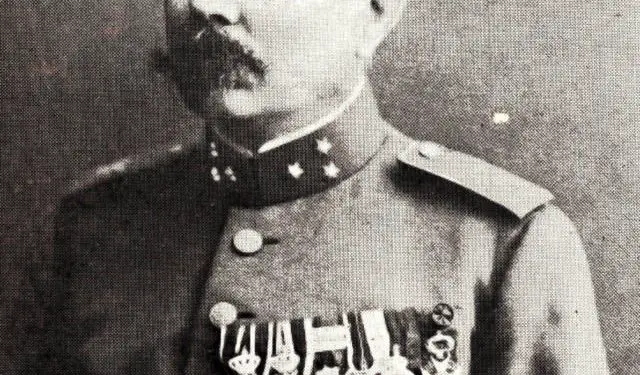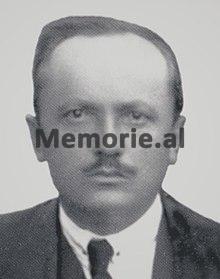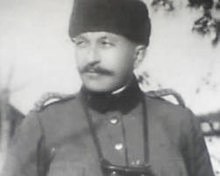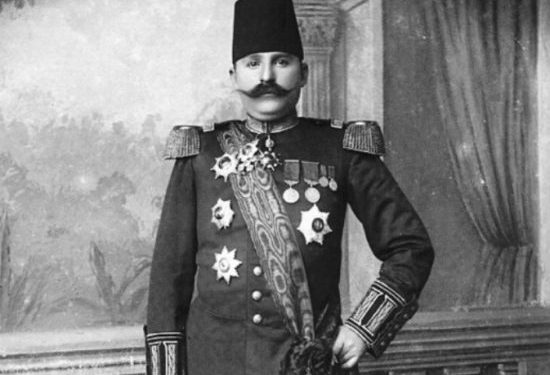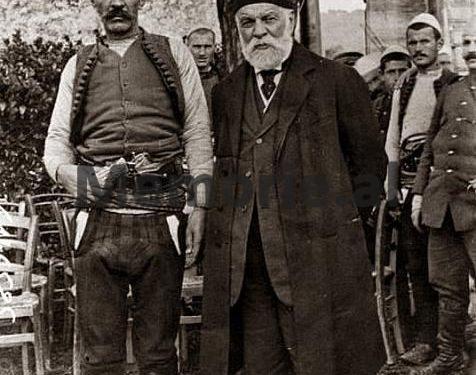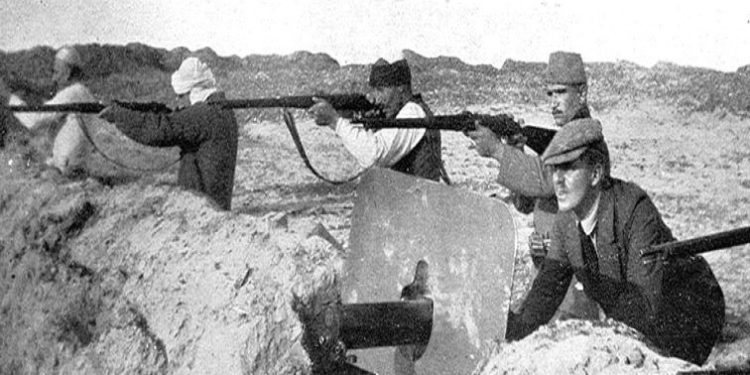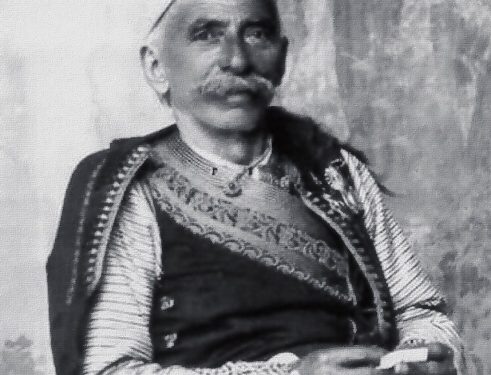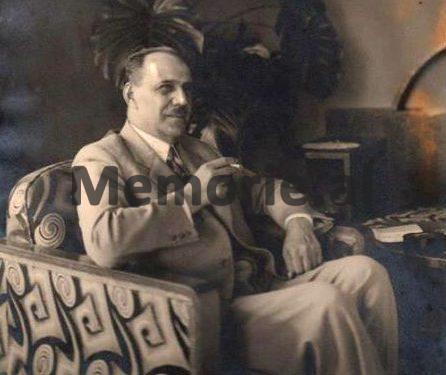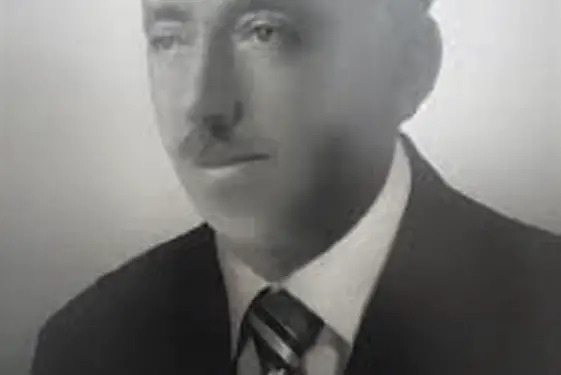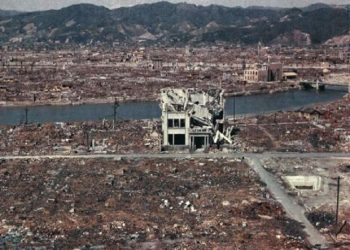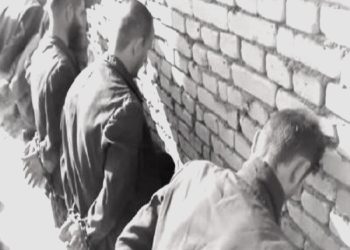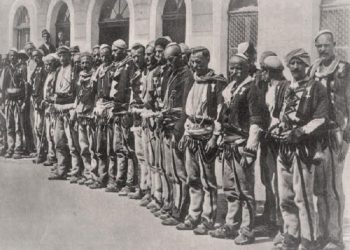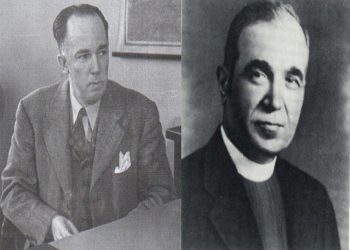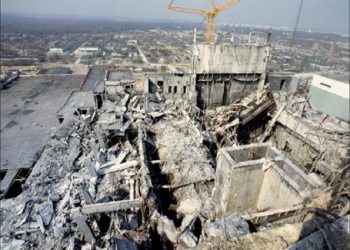By Sejfi Vllamasi
The third part
Memorie.al / From all the provinces of Albania, people’s delegates and a majority of patriots arrived, from inside and outside Albania, and on November 28, 1912, amid great enthusiasm, after 450 years of captivity, the flag was raised national and the independence of Albania was declared. A government was formed under the presidency of Ismail Qemali, in which Preng Bibdod Pasha also participated as deputy prime minister and Esat Pashë Toptani as minister of the interior. When Ismail Qemali arrives in Vlora, Seit Qemali, Murat Tërbaçi, Alem Mehmeti and many other patriots, as reservists, fought against the Greek army in Llogara. These, upon being informed about the purpose of the Elder’s arrival in Vlora, raised the national flag at the front of the war, before it was raised in Vlora.
Continues from last issue
The situation in Shkodër
In the Balkan war, the Mohammedans of Shkodra fought for 7 consecutive months, side by side with the Turkish army. Dibra volunteers also took part in the war and fought heroically against the Serbian forces, in the Bërdica war. The Catholic highlanders of the Great Highlands, who had taken part in the 1911 uprising against the errant Turkey, aided the Montenegrin army.
After the agreement for the defense of Shkodra under the national flag, Hasan Riza Pasha was killed. Esati handed over Shkodra to the Montenegrin army, which was forced to hand it over to international naval powers. Shkodra was later handed over to the international land powers, with the exception of Russia, which was placed under the command of the British colonel Phillips. They set up an administration with Albanian officials.
Esati, through his partisans, Alush Lohjes and his friends, tried to bring Shkodra under his influence. For this purpose, he had sufficient financial means provided by France, which was struggling in favor of Slavic influence, against Austria. On the other hand, the “Union Club” was formed in Shkodër, with 12 members, 6 Catholics and 6 Muslims, which included the nationalists of that time.
In February 1913, a meeting was held in Shkodër, that of Malevet, which included elements for and against Esat, in which the abbot of Mirdita also participated. As the orator that he was, they gave the floor to Nikollë Mirash, an Essadist from Kastrati, to explain the purpose of the meeting, who expressed himself as follows: “Masi Esati and Ismail Qemalin, they are Albanians and brothers, we will go to Esati”.
Ded Gjoluli replied: “Your word is not valid, since you are from Malaysia”. “If I myself am one time Malaysian, you are one hundred times Austrian”, says Nikollë Mirashi. Ded Gjoluli puts his hand on the rifle, but the abbot intervenes and thus a massacre is avoided. After that the meeting was dispersed.
Cuf Lohja (grandson of Alush Lohja) and Nikollë Mirashi, after the February gathering, get ready to go to Esati with 900 mountaineers, of which Esati kept only 50 people. Esati wanted this power, in order to unite it with the powers of Central Albania, overthrow Vidi and declare he head of state. Both Cufi and Nikollë Mirashi were Esat agents, but Cufi was also the commander of the volunteer forces. Esati goes to get Vid and the highlanders returned to Shkodër, awaiting his orders.
Esati, when he returned from Germany to his fiefdom in Laprakë, Tirana, called Cufi and Marash, from whom he asked for 2,000 mountain people, within 3 days. And when they were preparing the power, the news broke that Esati was bombed by Prince Vidi and that he left Albania. Cufin with Marash, calls Colonel Phillips, who tells them both, that those powers would go to the aid of Esat, to give them under the command of Preng Pasha, to the aid of Prince Vid. These two refused.
Esati leaves from Naples to Paris, where it connects with the French Government, and later goes to Athens and Nis. From Nish, he sends a letter to Alush Lohja in Shkodër, with Selim Xhija from Peqin, where he advises Shkodra to connect with the “ahli kijam” (the insurgent people), against Prince Vid.
In the castle of Shkodra, the flag was red and black, which was agreed upon by both sides, because the Muslims, despite the “Fatwa” given by the general mufti in Vlora, Haxhi Vehbi Dibra, did not accept the flag with the vulture. The Catholics were for Vid, and with the politics of Austria, while the Muslims with the propaganda of Esat, before they were for a Muslim king. Later, when Esati went to get Prince Vidin, except for Alush Lohje, they turned against him (Esati).
***
During the time of the international administration in Shkodër, relations between Muslims and Catholics were colder than in the time after the Turkish Constitution. At this time, between the two religious elements of the city of Shkodra, the animosity was more pronounced than in any other country in Albania, because the Catholic majority of the Prefecture of Shkodra was ruled by the Muslim minority, which was the majority in the city. The Muslims, favored by the Turkish Government, have taken an active part in the country’s administration, which participation has been extended to the mountains by means of a primitive system, with the “Kër Serdaran” and the “Jibala Kanun” (“The Law of the Mountains “).
The Muslims considered themselves more capable than the Catholics in the administration of the country, as was also the case in other parts of Albania, since the Muslims were officials and related to property, while Catholics were engaged in crafts and trade. The Muslims, dealing with administration and settling conflicts outside the city, had long since acquired a certain practical state culture and administrative skill.
With the political and financial support of Austria-Hungary, the Catholics built the Xaverian College of the Jesuits, the primary school of the Franciscans and the Nuns. This is how they contributed to the cultivation of the national language.
The animosity which occasionally arose between the two parties, has been rather caused by erroneous interpretations of events, by the touching words and acts of one or several persons, instigated by foreigners or fanatical lunatics, and it has been wrongly and unjustly accused, side where the culprit belonged. On the other hand, with the sudden disappearance of Turkish rule and the installation of an international regime, with a modern administration, a new situation was created for both sides. Since the Catholics were trained in the national language, they were favored as clerks, while the old Mohammedan clerks, since they lacked that preparation, remained outside the framework. This reversal of the situation had spiritual and material effects, as the Mohammedan side was affected in the conscience and in interest.
On the other hand, the vast majority of Muslims were for a Mohammedan king, who they considered as a guarantee of not violating their faith in the future. In Shkodër, at the time of the international, various newspapers were published. Among them “Sadai milet” (“Voice of the People”), which was published in the Turkish language, made propaganda and fought for a Muslim king. This newspaper was run by a commission made up of 6 people, from the country’s leaders, among whom Musa Juka and Ymer Lutfia have been the most active.
The old and new contradictions between the two elements of the city had caused an anarchic situation in Shkodër. In addition, both Esati and the Young Turks developed a great activity to turn the situation around, each in their own favor. The thesis of the Young Turks, “Union of Albania with Turkey”, was called an unrealizable dream by the Mohammedans. The mufti of Shkodra, Adem Efendiu, replied to Beqir Grebene: “In Turkey, we couldn’t keep him when we had him here, let alone let him fall again; such a claim scandalizes us in front of world opinion”.
At first the Catholics, under the leadership of Monsignor Serreq, Archbishop of Shkodra, went to Durrës and made the act of submission to Vid. Later, the majority of the Muslim people, after holding a meeting in the Mosque of Plaka, where the issue was discussed from a religious and national point of view, agreed that Vidi should be recognized as the King of Albania. For this reason, from the meeting, a commission of 18 people is chosen to go to Durrës and make the act of submission there.
Xhemal Najipi, the Kadi of Shkodra, receives a letter of recommendation from Colonel Phillips, for Vidi, to accept the commission in the audience directly, without the intermediary of Esat Pasha. The commission was accepted in March 1914, at 2:00 in the afternoon, and that’s how Shkodra got to know Vid. After a few days, Alush Lohja, at the head of the highlanders, his partisans, went to Durrës to meet Vid.
The uprising of the people of Central Albania against Vid
Esati, after inciting the people of Central Albania to revolt against Vidi, in order to become head of state himself, was forced to leave Albania. The first was Kavaja, the one that raised the flag of Turkey. Against this, the government decided to send a force, on May 23, 1914, composed of a company of gendarmes and volunteers from the mountaineers of Shkodra, who had come to Durrës, for the defense of Vidi. At the moment when this force was about to leave, Murat and Tefik Toptani hurriedly arrived in Durrës from Tirana, who found the situation there alarming and asked for power. Then the government changed the plan and under the command of Captain Sarr, a Dutchman, started a company of gendarmes, with Lieutenant Bajram Fevzina at the head, mountain volunteers and 20-30 nationalist volunteers, together with Reuf Fico, as sub-prefect of Tirana.
This power departs after midnight and takes a rest in Shijak. When he was about to leave for Tirana in the morning, the mountaineer volunteers were seen leaving, saying: “We have come to defend Vidi, not to fight” and returned to Durrës. Then Captain Xhavit Leskoviku informs Captain Sarri to return to Durrës, because with such a small force, they could not go to Tirana. Sarri insisted, but finally they asked the command by urgent telegram in Durrës. This telegram, unfortunately, fell into the hands of General Dewer, and not of Colonel Thomson, who gave the order to depart. The force started, but from the village on the hill to the left of Shijak, the war began and after a while, rifles began to be fired from all sides.
The government force retreats to the hill to the right of the road and is forced to return to Shijak, where most of the gendarmes enter a mud government building and another school. The war begins and several gendarmes are killed, by bullets that penetrate the walls of the mud building.
Captain Xhavit Leskovik, a major, advised Sarri that during the retreat, they should not stay in Shijak, but occupy Rrashbulli, to avoid encirclement. But Sarri, who did not know the country and the customs of the people, did not listen to him. Then the government power was surrendered, but the Shijakas later regretted it and to avoid the eventual responsibility, they said that the government broke the promise. Captain Xavit Leskovik, answered; “However it was done, we will issue an apology decree from Vidi, and the matter will be closed.”
Sarri goes to Durrës and received the decree, but unfortunately he returned late. The Shijakas occupied Rrashbulli, before the nationalist volunteers, with whom I also participated, occupied it. The commander of this force, which consisted of 50-60 people, was Captain Meleq Frashëri, who advised General Dewer, saying that Rrashbulli could not be attacked, with such a small force and without military preparation!
The Dutch general, who by all accounts was not at the height of his mission, did not accept his opinion and ordered the attack to begin, on May 23, 1914. The mounted angel, together with the volunteers, charged towards the road on both her arms. Meleqi was wounded and 13 people were killed by the volunteers, including Ceno Shara and Haki Glina. A part of the volunteers became prisoners and the rest retreated towards Durrës.
With the complete defeat of the volunteers, the road to Durrës was open to the rebels. Durrës, in a panic, awaited their arrival, and Vidi, together with his government and a majority of dignitaries, entered the steamer.
Vidi sends Mehmet Pashë Dralla, with a white flag in hand, for a truce. The war itself had stopped, but the insurgents did not take advantage of their sudden victory. At that time, part of the insurgents of Kavaja, sounding the trumpet, went to Shijak, who caused the agreement to be broken and remain without releasing the prisoners of war, when Captain Sarri gave a speech in front of the insurgents, and at the end of his speech, called; “Long live Albania”!, they answered; “Long live Baba Dovleti”! (Long live the King of Turkey).
Later, the Control Commission arrives in Shijak, where the delegate of Austria, August Krali, Consul General, gave a speech to the Albanian insurgents, saying: “The father you are looking for was not driven out by the Albanians, but by your enemies. , Serbs and Greeks. He was forced to flee Albania himself. These things you do are stupid, so give up, because the Serbs will come and slaughter everyone”.
The captives were released. Colonel Tomsoni is well informed about the development of events by Captain Xhavit Leskoviku and disapproves of Dewer’s order to send forces to Tirana. Then he asks the Albanian government to choose one of the two as commander. The Government selected Thomson and notified the Dutch Government, as stated above, which summoned Dewer.
Thomson, together with Xhavit Leskovic, prepared a line of defense, as it was thought that the insurgents would surely attack Durrës. The line of defense, which started from Ura e Dajlan, to Bishti i Palla, was constantly protected by gendarmes and volunteers.
On May 23, 1914, Tirana fell into the hands of the insurgents
On June 15, close to dawn, the insurgents attacked Durrës from Bishti i Palla, with 500-600 shijakas and from Ura e Dajlani with kavajas, commanded by Sheh Hamdi Shijaku. The government power bravely met the attack. Both sides fought heroically. The insurgents were routed, leaving many dead. Their commander Sheh Shamdiu was injured and recovered in Durrës hospital. In the war from the side of the hills, Captain Kamber Sejdini, a veteran patriot and one of the most distinguished officers of Albania, was killed.
Colonel Thomson, together with several leaders of the volunteers, was at Gazhane, where he controlled the war. A kavajas sneaks across the Dajlan Bridge and across the sea, approaches Gazhana, hides behind a bush and from there shoots and kills Tomson. After that, he also kills Ajdin Draga, the brother of Nexhip Draga, without understanding at all where the bullets were coming from. But a curvaceous gendarme dictates the kavajasi and a shooting duel begins between the two parties, which ends with the kavajasi’s murder.
The assassination of Colonel Thomson made an extremely large impression in Durrës and had an almost decisive effect on the fate of the events of that time. The uprising of the people of Central Albania was a conspiracy organized by the internal and external enemies of Albania, to prevent the stabilization of the Albanian state, created by the six Great Powers at the London Conference, with Vidi as king, and in order to create new conditions in their favor, according to the goals pursued by each participant in the conspiracy.
Internal enemies: a) Esat Pashë Toptani with his partisans, whose goal was to expel Vidi, overthrow his government and declare himself the head of the Albanian state; b) the Turkomans, such as Musa Qazimi, the mufti of Tirana, and Qamil haxhi Feza (Elbasana), etc., who wanted the union of Central Albania with Turkey, but if this would be impossible, then the choice of Burhanedini, the son of Sultan Hamit, as King of Albania.
Esati initially accepted the opinion of the Turkomans, in order to ensure their cooperation in reversing the situation. The external enemies were: the Young Turks, France, Italy, Greece, Serbia and Montenegro. All of these, with the effective support they gave to Esat and the Turkomans, wanted the dismemberment of Albania. While the insurgent mass, fantasized by the Esadist and Turkophile propaganda, wanted to expel Vidi and reunite with Baba.
The people of Central Albania, with a muscular and deeply religious character, have lived far from Serbo-Greek barbarism. This people, led by fanatical and ambitious people and with a very low political level, threw themselves without reserve into a fanatical war against their own country, unknowingly serving their external enemies.
The uprising against Vidi began at a favorable time for the country’s enemies, precisely when the people of South Albania were engaged in a life-or-death struggle with the Greeks, to defend their country against invasion, against the Vorio autonomy. -Epiriote and its government led by Zografos, from Qestorati. The prime minister of Serbia, Pashiqi, also made these criminal toys in order to set up a Zograf-type government in Dibër, under the leadership of Arif Hiçmet, from Kumanovo.
Musa Qazimi and Qamil Haxhi Feza, in May 1914 made the “Treaty of Kruja”, where they decided the war against Vidi and the union of Albania with Turkey, with King Burhanedin at the head. At the beginning of June, the “ahli-kijami” (rebellious people) occupied Kruja and Kavaja. The insurgents in the invaded countries formed councils among the cities and villages, which elected the general council, whose main mission was to lead the uprising.
On June 3, before the whole of Central Albania was invaded, a council meeting was held in Shijak, where the general council was elected first, as follows: president Mustafa Ndroqi (Esadist), vice president Xhenabi Adili (Young Turk), major of the Turkish army, and commander-in-chief, Qamil Haxhi Feza (Turkman) from Elbasana. This election shows a coalition made with mutual concessions of the participants, for a common goal: to expel Vidi and overthrow his government. The uprising continued to spread. On June 17, the government power of Asia Pashë Vrion deserts and Lushnja is occupied by the rebels, as well as Elbasan on June 2.
After Elbasan, Čermenika, Quksi and Mokra, one after the other, join the insurgents. After the occupation of Elbasan, Korça remains separated from Durrës and alone in front of the Greek front. The prefecture of Korça sends a well-organized force of volunteers from Kolonje, about 400 people, under the command of Izet Zavalani, to open the way and to ensure the connections with Durrës. This power, despite being advised by the patriots of Pogradec, not to start the war in the Plečishti Hills near Mokra, since that province had joined the insurgents, started the war against the much larger power of Osman Çota. The war became fierce.
Ibrahim Baçi from Mokre, and Muharrem Udinishti, took the arms of the colonists, who were forced to retreat, leaving nearly 50 dead, among them Zalo bey Prodani. The latter, a 75-year-old man, fought in the square in the form of a duel, with Azis Alla, where both remained. Gani Butka was also treacherously killed, wounded while retreating, from bullets coming from a window in Pogradec. / Memorie.al
The next issue follows




